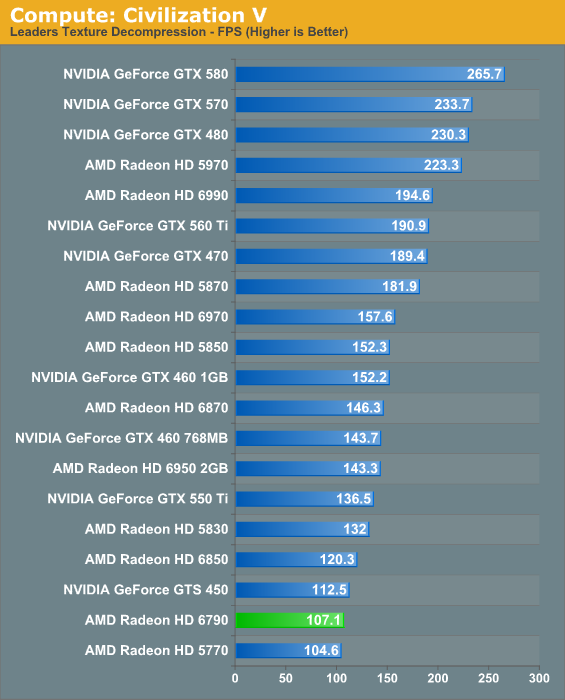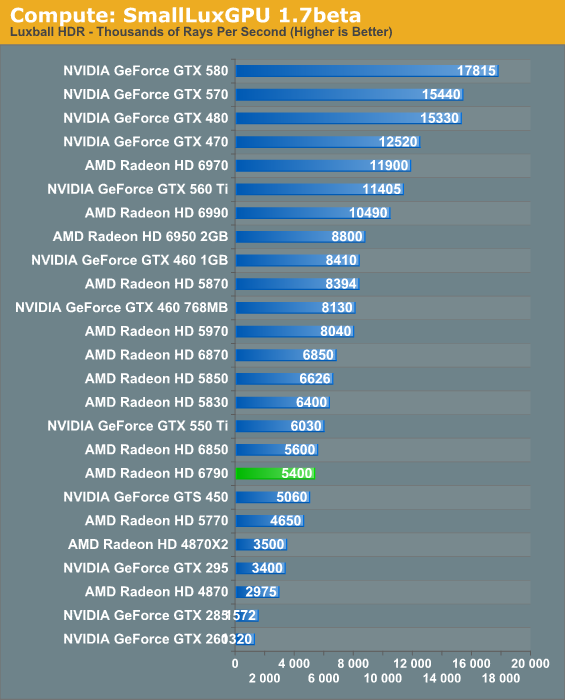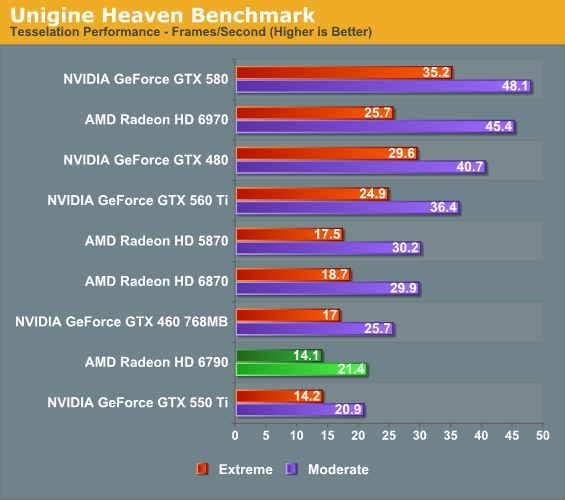AMD's Radeon HD 6790: Coming Up Short At $150
by Ryan Smith on April 5, 2011 12:01 AM ESTCompute & Tessellation
Moving on from our look at gaming performance, we have our customary look at compute performance, bundled with a look at theoretical tessellation performance.
Our first compute benchmark comes from Civilization V, which uses DirectCompute to decompress textures on the fly. Civ V includes a sub-benchmark that exclusively tests the speed of their texture decompression algorithm by repeatedly decompressing the textures required for one of the game’s leader scenes.

Civilization V’s compute benchmark cares little for memory bandwidth or the architectural differences between Barts and Juniper; SPs and clockspeed are what matter here. As a result the 6790 narrowly averts a tie with the 5770 of all things, and the performance relative to NVIDIA’s cards isn’t any better.
Our second GPU compute benchmark is SmallLuxGPU, the GPU ray tracing branch of the open source LuxRender renderer. While it’s still in beta, SmallLuxGPU recently hit a milestone by implementing a complete ray tracing engine in OpenCL, allowing them to fully offload the process to the GPU. It’s this ray tracing engine we’re testing.

SmallLuxGPU ends up being one of the best showings for the 6790, as while it’s obviously compute bound, it definitely benefits from the architectural differences between Barts and Juniper. The 6790’s performance relative to the 6850 almost identically matches the theoretical performance difference, and in spite of the 5770 having a slight theoretical advantage of its own, the 6790 easily beats the 5770 by 16%. This opens up a small window for the 6790 as a lower-priced GPGPU product, but it’s a very small window – the program would need to excel on AMD cards and on Barts over Juniper. Otherwise we see SLG where the 6790 does well versus the 5770, but very poorly compared to NVIDIA’s cards.
At the other end of the spectrum from GPU computing performance is GPU tessellation performance, used exclusively for graphical purposes. Barts’ tessellation improvements should give it an edge over the 5770, but it still has to contend with the 6800 series.


At this point in time none of our games closely match our tessellation results, which shouldn’t be a surprise given the low usage of tessellation. Although Barts isn’t a tessellation monster it could do quite well in the future if tessellation takes off in a manner similar to how these benchmarks use it, but that’s a very big if.










69 Comments
View All Comments
silverblue - Tuesday, April 5, 2011 - link
Until we shift from 40nm, probably.mgl888 - Tuesday, April 5, 2011 - link
Not much they can do without a process shrink. Architectural improvements can only go so far.Taft12 - Tuesday, April 5, 2011 - link
No, there is no wall to speak of. The 4870 was a "first tier" part and this 6790 is "third tier". Compare the performance of the 4870 with a 6970 instead (and indeed the launch price of the 4870 with the launch price of the 6970) and you'll see we are doing just fine thank you very much.tno - Tuesday, April 5, 2011 - link
But not long after release the 4890 was retailing after discounts for $160-150. That's what I bought mine at and I have yet to find a compelling card to take its place. Part of that does have to do with a decrease in my gaming, but if I was a budget gamer, I would look long and hard at a used 4890.tno - Tuesday, April 5, 2011 - link
+1pandemonium - Wednesday, April 6, 2011 - link
Only if you don't consider the broad picture and are looking at performance individually.marc1000 - Tuesday, April 5, 2011 - link
I have a 5770. and even with the desire to upgrade to 6950/gtx570, i try to remain honest with me and tell to myself: "I don't need it"this level of performance if perfectly fine to play all current games, because we are all stuck with console ports...
jordanclock - Tuesday, April 5, 2011 - link
I have a 5770 as well, and at 1680x1050, almost everything runs flawlessly, even with AA at 2x or 4x. The situation with multiplatform development is starting to really agitate PC gamers, I think. Crysis 2 looks infinitely better on PC (And ultra high end setups run tri-monitor quite well!), Dragon Age 2 has a texture pack that consoles wouldn't even have the memory to use, and so many games are looking identical on PC and console, meaning that while they run at high framerates on modest hardware, there is no option to increase visual fidelity to offset the increased hardware.tno - Tuesday, April 5, 2011 - link
I concur. I have a 4890 that I picked up for $160 not long after its release after discounts. This thing was top tier, and it was pretty unique product coming out when ATI started treating their multi-GPU single card solutions as their true halo products. And for its flaws (noisy, power hungry and no DX11) it competes for performance at its original price.This is mirrored, frankly, in the PC market where the effective performance increase, that is performance that the average PC user (not us) will notice, has remained fairly flat since Conroe. What has improved is features. For that same budget dual-core Conroe price you get an integrated GPU worth its salt, improved efficiency, improved encoding/decoding performance (the thing users might notice most) and, possibly, more cores.
kmmatney - Tuesday, April 5, 2011 - link
I also have a HD4890, bought for $170, and attached an Accelero S1 cooler, so its virtually silent (only a very slow spinning fan that I can't hear across the heatsink). I'm still amazed after so much time that I cannot get a better card for the same price - things just haven't progressed much in the bang-for-buck department.